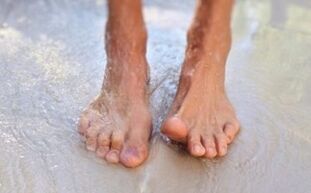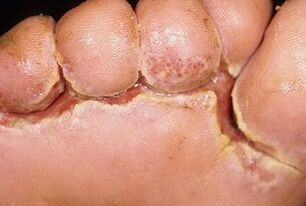About 80% of the population is affected by fungi on the skin. Due to the increased density and sweating, mycoses are more affected by the skin on the feet. The fungal infection is manifested by peeling and itching, but can also be asymptomatic, causing only the appearance of seals (blisters, corns - hyperkeratosis on the heels and arches of the feet). If left untreated, the infection spreads. The patient can infect others, spread germs throughout his body.
Where did the mushroom come from

Fungal microorganisms love a humid and warm environment and an abundance of nutrients. As a "shelter" they use thick skin, prone to increased secretion of fat and sweat.
Human feet - always act as a favorable place for the multiplication of mycobacteria, and poor quality socks and shoes contribute to this.
You can get infected in a public place - on the beach, in the sauna, in the pool. You can bring the infection when trying on new shoes, because a person with mycosis of the foot could measure it the day before.
Some internal factors also increase susceptibility to fungi:
- weakness of immunity - fungi refuse the body's defenses, when they are weakened, microorganisms penetrate the skin more easily;
- endocrine disorders - diabetes mellitus and hormonal imbalance change the composition of skin secretions turning them into fertile ground for bacteria;
- permanent injuries - cracks, scratches, abrasions and stings can be the entrance for fungi;
- lack of hygiene - poor foot washing, use of dirty socks and waterproof shoes contribute to the invasion of fungus on the limbs.
Infection is also possible from a loved one - if there is a patient or carrier of the fungus in the house with an asymptomatic course of the disease. Disputes about pathogenic microorganisms have spread to household appliances, personal belongings, gender (if the patient moves barefoot). When washing the belongings of all the inhabitants of the house, mycobacteria get on the clothes of healthy family members, they can cause mycosis not only on the feet, but also on other parts of the body (in the folds, groin, hairy areas of the body).
Why does the fungus appear between the fingers
Interdigital fungus is a special clinical form of foot mycosis. Doctors call it intertriginous. With this course, the skin is affected between 3 and 4 or 4 and 5 fingers. Often the pathological process begins on one limb, eventually spreading to the healthy.

Mycosis begins with cracking of the skin between the toes or at the base of the phalanx on the foot. The size of the injury can be from 2-3 mm to 1 cm. The intensity of the symptoms depends on the surface of the wound - the bigger the injury, the stronger the pain. At the time of the crack, the person feels a slight discomfort when walking, which is increased by hygienic procedures.
Unlike other injuries, a crack does not heal on its own. It ignites, secretes exudate. The surface between the fingers becomes wet, which additionally contributes to the spread of the fungus to larger areas of the skin. An "edge" appears around the injury - it’s steamed peeled skin. The separation is quite dense, attempts to remove the fingers end in injuries to healthy parts of the skin. Permanent peeling appears around the lesion. It can be lamellar or floury. The scales are silvery, white, yellowish. These characteristics depend on the strain of the fungus that infects the skin. Once the crack heals, the intriguing form of mycosis turns flat - it manifests as extensive dry areas on the foot, with an abundance of scaly scales. The surface can be shiny or tissue-like.
What to do with the symptoms of the fungus
If you have a crack between your fingers surrounded by sagging skin, you should definitely visit a dermatologist. The specialist will conduct an examination, determine the symptoms not only at the site of injury, but also on other parts of the limbs.
Diagnosis cannot be made on the basis of symptoms alone. Microscopic examination of the skin scraping from the feet will be required to confirm the fungus. In the case of resistant mycosis, it is supplemented by PCR analysis or inoculation of the culture to determine the type of pathogen and its susceptibility to fungicidal drugs.
In advanced cases of fungus or extensive dermis lesions, systemic medications will be required. Due to the likelihood of hepato- and nephrotoxic effects of such drugs, the patient should undergo blood and urine tests. Based on their results, the specialist assesses the function of vital organs, selects a treatment regimen with systemic antifungals.
Self-treatment of fungal infections of the feet is allowed only in the early stages. You can deal with topical medications that do not have systemic side effects.
Effective drugs against interdigital fungi
The characteristics of therapy depend on the individual patient's data, the degree of mycosis, the area of the lesion, the presence of a secondary infection, or the resistance of the pathogen.
Systemic drugs
To speed up treatment and make it complete, doctors prescribe antifungal agents in the form of tablets or capsules.
During treatment with systemic drugs, it is undesirable to consume alcohol, fatty foods and other foods that create a burden on the liver. If the infection has spread to the nails from the interdigital space, prolonged use of antifungals will be required.
Local remedies
For the treatment of interdigital fungi, drugs are prescribed on a moderately oily or non-oily basis (creams, solutions). The ointment can be used only in the initial stage when skin softening is needed for rapid healing of the lesions. Medicinal and antiseptic drugs can be prescribed along the way. They accelerate the regeneration process and additionally soften rough skin.
External agents with broad-spectrum fungicidal components are prescribed for the treatment of foot fungus. Ideal for products based on:
- terbinafine;
- clotrimazole;
- ketoconazole;
- econazole;
- naftifina.
Price does not affect the success of treatment, it is important to choose the right active ingredient of the drug.
Creams and solutions are applied to the skin 1-2 times a day after hygienic procedures. After processing, the product can be completely soaked and wear cotton socks. In parallel, it is necessary to disinfect the shoes every 3-7 days. Fungicide sprays are used for this. It is necessary to regularly change socks, underwear, towels. Used items should be washed at elevated temperatures separately from other accessories for the patient and his family members.
In trichophytosis and microsporia, doctors recommend special treatment regimens. For example, treatment with iodine solution in the morning and sulfur, sulfur-tar or salicylic ointment in the evening.
Folk remedies
You can not treat fungus only folk methods. Baths are allowed in addition to medication. If your doctor has advised the use of homemade ointments or formulations, they should be used separately from pharmaceutical preparations. For example, in the morning and evening use ready-made medicines, and in the afternoon - homemade ointment. The most popular methods of treating fungus among humans:
- oak bark baths- make a large amount of soup from oak bark (6 tablespoons per 1 liter), dilute it in half with clean water, bathe for 15 minutes a day;
- with sea salt- prepare a strong solution of sea salt, bathe for 10 minutes, do not wash off the salt, put on cotton socks immediately after the procedure;
- with soda- dilute a tablespoon of soda to 1 liter of water, bathe for 15 minutes, after wiping apply anti-fungal pharmaceuticals;
- egg fat- 1 chicken egg is mixed with a tablespoon of oil and vinegar, stir until smooth, put 3-4 hours under the bag, rinse with water;
- tea tree- areas affected by fungi are abundantly lubricated with tea tree essential oil, rinsed after 3 hours, with sensitivity, the oil is diluted in half with neutral fats.
Quick cure of fungi facilitates the rejection of sweets, alcohol, fatty foods. The patient's diet should include lots of vegetables, fermented dairy products, whole grain cereals.
To prevent fungus on your feet and between your toes, you should take good care of your foot hygiene. When visiting public places, avoid walking barefoot, use fungicides - any antifungal ointments or sprays are applied after showering. New shoes should only be measured in new socks; you must not give slippers to anyone.
























